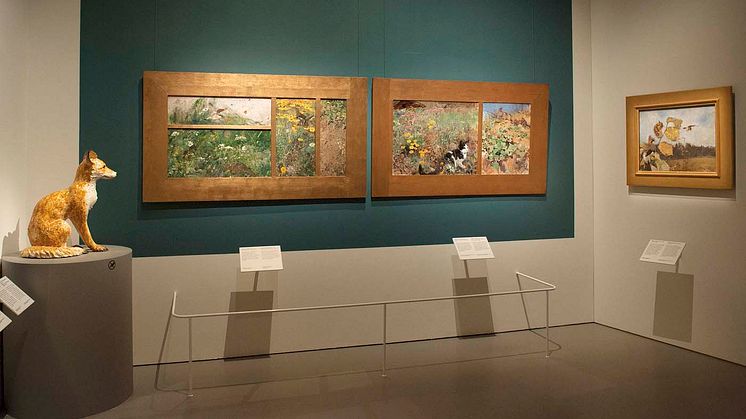
Press release -
Liljefors paintings reunited at Nationalmuseum
The recent acquisition of a Bruno Liljefors painting has enabled Nationalmuseum to recreate one of the artist’s most ambitious works. Cat in a Summer Meadow was composed alongside Nestlings of Red-Backed Shrike, already in the museum’s collection. Now, the two paintings can be displayed in a single frame, as the artist originally intended. They can be seen in the Highlights exhibition, along with four other paintings that were part of the original whole.
In 2013, Nationalmuseum acquired Cat in a Summer Meadow, painted by Bruno Liljefors in 1887. As a result of this acquisition, it has now been possible to recreate one of Liljefors’ most ambitious works so that visitors can experience it as the artist intended. The painting has been reunited with Nestlings of Red-Backed Shrike from the museum’s collection, and both pieces have been mounted in the same single frame that they originally occupied. Seen alongside the cat motif, Nestlings appears in a new light. Liljefors clearly composed the two paintings at the same time, since they are so well balanced in relation to each other in terms of both form and colour.
The paintings have also been reunited with Four Bird Studies. This work too was conceived as part of the original whole and was acquired by Nationalmuseum in 1992, along with Nestlings. The marks on the back of the frames indicate that the six paintings were hung together, and how they were positioned relative to one another. From the starkly pared-down composition and the mounting of multiple paintings in a single frame, it is clear that Liljefors was influenced by Japanese art, which was fashionable in the latter half of the 19th century.
The Highlights exhibition also presents some of the other acquisitions added to Nationalmuseum’s collections in recent years. One such piece is Alexander Roslin’s 1767 portrait of himself and his wife, Marie Suzanne Giroust, acquired late last year. Another is the terracotta sculpture Satyr and Nymph by Claude Michel, known as Clodion, from the 1780s. Among the more recent works on show is a 3D-printed nylon urn, designed and produced by Michael Eden in 2011, which was acquired in 2013. Nationalmuseum has no budget of its own for new acquisitions, but relies on gifting and financial support from private funds and foundations to enhance its collections of fine art and craft.
The Bruno Liljefors paintings can be seen together in Nationalmuseum’s Highlights exhibition at Konstakademien, Fredsgatan 12, Stockholm, until 31 August 2014.
Further
information for press
Mikael Ahlund, curator, mikael.ahlund@nationalmuseum.se, +46 8 5195 4454
Hanna Tottmar, press officer, hanna.tottmar@nationalmuseum.se, +46 767 23 46 32
Caption
Bruno Liljefors, Four Bird Studies, Cat in a Summer
Meadow and Nestlings of Red-Backed Shrike, 1887. Photo: Sofia
Persson/Nationalmuseum.
Categories
Nationalmuseum is Sweden’s premier museum of art and design. The collections comprise older paintings, sculpture, drawings and graphic art, and applied art and design up to the present day. The museum building is currently under renovation and scheduled to open again in 2017. In the meantime, the museum will continue its activities through collaborations, touring exhibitions and a temporary venue at the Royal Swedish Academy of Fine Arts, Fredsgatan 12, Stockholm. Nationalmuseum collaborates with Svenska Dagbladet, Fältman & Malmén and Grand Hôtel Stockholm. For more information visit www.nationalmuseum.se.

